

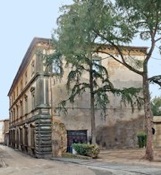
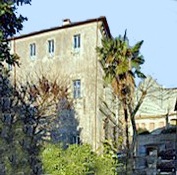
History of the Site
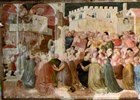
The nuns of the adjacent nunnery of San Bernardino acquired the site, probably in the 16th century.
Present Palace
Vicenzo Buzi bought the vineyard and orchards here from the nuns of San Bernardino in 1581, and commissioned Ippolito Scalza to build this palace on the site.
Towards the end of the 18th century, the palace belonged to the Gualterio family. They exchanged its portal for one from their Palazzo Gualterio, evidently wishing to place the more impressive portal on their more centrally located palace.
Count Francesco Pallucco, who served in the first local government of Orvieto after its incorporation into the new Kingdom of Italy in 1860, and who was its mayor in 1871-3, bought the palace in 1877. He sold it in 1885 to Countess Faustina Mazzocchi; he transferred its furnishings to Palazzo Faina, which had belonged to the family of his wife, Clelia.
The palace passed to the Padri Mercedari, its current owners, in 1899. [The Padri Mercedari belong to the Congregazione di Santa Maria della Mercede, an order that had settled in San Lorenzo de’ Arari in 1715. The word “Mercede” is the Spanish version of “Misericordia”, which means something like “loving kindness”. ] The fathers made a number of changes in order to provide cells and a new chapel.
The palace is now known as Villa Mercede and offers accommodation.
Interior
Frescoes (ca. 1585)
The frescoes that Vincenzo Buzi commissioned for the rooms of his new palace are attributed to Cesare Nebbia and Giovanni Battista Lombardelli. they include:
-
✴the frescoes of two rooms on the ground floor, which depict allegories; and
-
✴those of a number of rooms on the piano nobile, which depict scenes from the Old Testament.
Frescoes (ca. 1880)
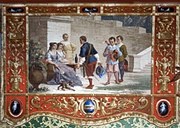
These frescoes in one of the three rooms on the piano nobile, which includes the coats of arms of the Pallucco and Faina families, are attributed to Mariano Piervittori. They include this fictive banner, which depicts a scene of a nobleman presenting his regards to two ladies.
Finds from Palazzo Buzi (5th century BC)
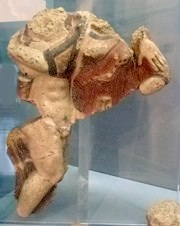
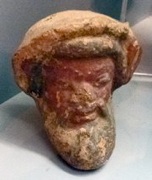
The following terracotta objects, which were found at Palazzo Buzi [when??], are exhibited in the Museo Civico:
-
✴a fragment of a painted terracotta relief of a snaked man; and
-
✴the head of a satyr.

